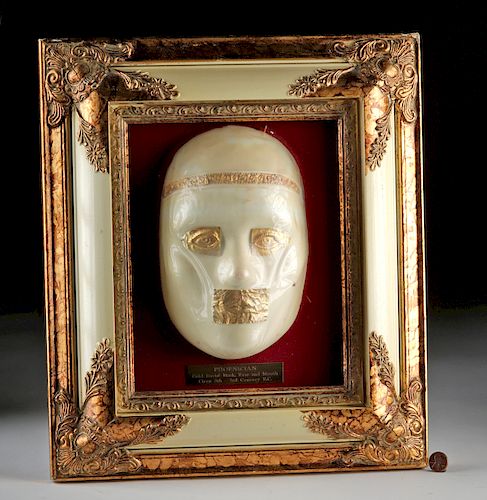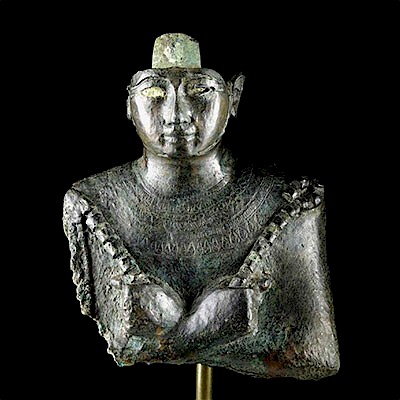Framed Phoenician Gold Burial Mask Components
Lot 62
About Seller
Artemis Gallery
686 S Taylor Ave, Ste 106
Louisville, CO 80027
United States
Selling antiquities, ancient and ethnographic art online since 1993, Artemis Gallery specializes in Classical Antiquities (Egyptian, Greek, Roman, Near Eastern), Asian, Pre-Columbian, African / Tribal / Oceanographic art. Our extensive inventory includes pottery, stone, metal, wood, glass and textil...Read more
Estimate:
$3,000 - $4,500
Absentee vs Live bid
Two ways to bid:
- Leave a max absentee bid and the platform will bid on your behalf up to your maximum bid during the live auction.
- Bid live during the auction and your bids will be submitted real-time to the auctioneer.
Bid Increments
| Price | Bid Increment |
|---|---|
| $0 | $25 |
| $300 | $50 |
| $1,000 | $100 |
| $2,000 | $250 |
| $5,000 | $500 |
| $10,000 | $1,000 |
| $20,000 | $2,500 |
| $50,000 | $5,000 |
| $100,000 | $10,000 |
| $200,000 | $20,000 |
About Auction
By Artemis Gallery
May 22, 2019
Set Reminder
2019-05-22 10:00:00
2019-05-22 10:00:00
America/New_York
Bidsquare
Bidsquare : Exceptional Day 1: Antiquities Asian Fine Art
https://www.bidsquare.com/auctions/artemis-gallery/exceptional-day-1-antiquities-asian-fine-art-4129
Day 1 of an important 2-day auction featuring exceptional art from around the world - Egyptian, Greek, Etruscan, Roman, Viking, Russian, Near Eastern; Asian Art from China, Japan, Thailand, Vietnam, Burma, India; Fine Art from the 17th century to present. Artemis Gallery info@artemisgallery.com
Day 1 of an important 2-day auction featuring exceptional art from around the world - Egyptian, Greek, Etruscan, Roman, Viking, Russian, Near Eastern; Asian Art from China, Japan, Thailand, Vietnam, Burma, India; Fine Art from the 17th century to present. Artemis Gallery info@artemisgallery.com
- Lot Description
Ancient Eastern Mediterranean, Phoenicia, ca. 6th to 4th century BCE. The stunning eyes, mouth, and diadem from a gold burial mask. Each piece is a masterwork of the repousse technique, with lifelike eyes, lips, and decoration formed from thin gold sheet. The gold is 87% pure, equivalent to 21K. The eyes have clearly delineated eyelashes, small lids, and are depicted as if in life despite being from a funerary mask: open and focused. The mouth is closed, with small, full lips. The diadem has an even, studded pattern along its length. Here they are displayed on a modern cast of a face, mounted on a modern red cloth backing in a modern gilded wood frame. Size of mouth (largest piece: 2" W x 1.2" H (5.1 cm x 3 cm); size of frame: 13.55" W x 15.75" H (34.4 cm x 40 cm); gold is 87% pure, equivalent to 21K
Members of Phoenician royalty were buried with gold death masks, or with their eyes and fingernails covered with gold and/or silver foil like these examples. An inscription on the sarcophagus of Batnoam, mother of the Byblian king Ozbaal, tells us that she was buried with a gold mouth band. The gold foil style echoed a similar burial practice in Egypt. People believed that these precious metals created safe passage for their loved ones into the world of death - and showed off the wealth that they had in life.
Provenance: private California, USA collection; ex-Arte Primitivo, New York, USA, purchased 20 years ago
All items legal to buy/sell under U.S. Statute covering cultural patrimony Code 2600, CHAPTER 14, and are guaranteed to be as described or your money back.
A Certificate of Authenticity will accompany all winning bids.
We ship worldwide and handle all shipping in-house for your convenience.
#145836Eyes, mouth, and diadem are the ancient pieces here; the white face is a modern plastic cast and the frame and fabric are from the 20th century. The ancient gold has some tiny tears at the edges, mainly on the mouth and diadem, and is slightly bent. The eyes, particularly, are in excellent condition. They have not been examined outside of their frame.Condition
- Shipping Info
-
All shipping is handled in-house for your convenience. Your invoice from Artemis Gallery will include shipping calculation instructions. If in doubt, please inquire BEFORE bidding for estimated shipping costs for individual items.
-
- Buyer's Premium



 EUR
EUR CAD
CAD AUD
AUD GBP
GBP MXN
MXN HKD
HKD CNY
CNY MYR
MYR SEK
SEK SGD
SGD CHF
CHF THB
THB














